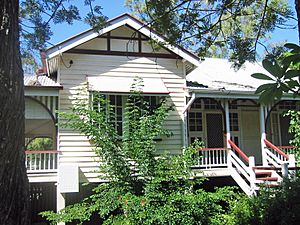St Andrew's Rectory, Toogoolawah facts for kids
Quick facts for kids St Andrew's Rectory, Toogoolawah |
|
|---|---|

St. Andrew's Anglican Rectory, 2012
|
|
| Location | Mangerton Street, Toogoolawah, Somerset Region, Queensland, Australia |
| Design period | 1919 - 1930s (interwar period) |
| Built | 1925 |
| Official name: St Andrew's Rectory | |
| Type | state heritage (built, landscape) |
| Designated | 21 October 1992 |
| Reference no. | 600501 |
| Significant period | 1920s (fabric, historical) |
| Significant components | residential accommodation - rectory, garden/grounds |
| Lua error in Module:Location_map at line 420: attempt to index field 'wikibase' (a nil value). | |
St Andrew's Rectory is a special old house in Toogoolawah, Queensland, Australia. It's called a "rectory" because it was built for the priest of St Andrew's Anglican Church. This house was built in 1925 and is now protected as a heritage site. This means it's an important part of Queensland's history and should be kept safe for the future.
History of the Rectory
This single-storey house was built in 1925. It was made to be the home for the priest of St Andrew's Anglican Church in Toogoolawah.
How the Parish Started
The area around Toogoolawah became its own church "parish" in 1917. Before that, it was part of the Esk parish. This change happened because more people were moving to Toogoolawah. Many people came to work at the successful Nestle's condensed milk factory, especially during the First World War.
A Gift of Land
In 1920, a kind lady named Mary McConnel helped the church. She was from Cressbrook Station. She had already given the land for St Andrew's Church in 1911. Now, she gave two more pieces of land on Mangerton Street. These pieces were between the church and the church hall. The plan was to build the rectory on this new land.
Building the House
In 1924, the church asked local builders to create plans for the rectory. It was probably built by a contractor named AD Menzies. He built many buildings in Toogoolawah around that time. Work on the house started in January 1925. It was finished by late May of the same year. The cost to build it was £1,008.
One Parish, One Home
In 1928, the church parishes of Esk and Toogoolawah joined together. They became known as the Brisbane Valley parish. Since then, the priest for this combined parish has always lived in the rectory at Toogoolawah.
What the Rectory Looks Like
This house is made of timber and has one main floor. It sits among old trees, including some tall palm trees. The land around the house is part of the church area. It also borders McConnel Park.
Outside Features
The house has covered porches, called verandahs, on its north and west sides. It stands on concrete stumps, which lift it off the ground. There's a partly closed space underneath the house. The outside walls are made of weatherboard, which are long, overlapping timber planks. There are timber strips between the stumps.
The verandahs are wide and have pretty timber decorations. These include a fancy border (valance) and railings (balustrades). The railing is low and wide, so it can be used as a seat. You enter the house from the west side using stairs that turn a quarter of the way. The front door has decorative glass panels on the sides (sidelights) and above (fanlight). It opens into a small entry area called a foyer. A narrow study room opens off the west verandah. It has a pointed roof section (gable) facing the street. The kitchen on the east side of the house also has a similar pointed roof section.
Inside the House
Inside, the walls are made of single layers of VJ boards. These are timber boards with V-shaped grooves. French doors with fanlights above them open onto the verandahs. The ceilings are also made of timber boards. There's a decorative, pointed timber archway between the foyer and the living room. The covers over the windows are made of corrugated iron and have timber supports (brackets).
A driveway runs from the north, going behind the church and church hall, leading to the rectory.
Why It's Important
St Andrew's Rectory was added to the Queensland Heritage Register on 21 October 1992. This means it's officially recognized as an important historical place. Here's why:
Showing Queensland's History
The rectory was built in 1925. It helps us understand how the Anglican Church grew and became stronger in Toogoolawah over time.
A Great Example of Its Kind
This house is a good example of a typical Queensland house from the 1920s. It's still in very good condition and shows the main features of houses from that period.
Beautiful to Look At
People in the community value the rectory for its beauty. The house and its grounds add to the nice look of Toogoolawah town. The timber verandahs, in particular, are considered very attractive.
Strong Community Connection
St Andrew's Rectory is very important to the Toogoolawah community. It's a key part of a historic and beautiful area. This area includes St Andrew's Church, the church hall, the rectory, and the nearby McConnel Park (which has the Toogoolawah War Memorial).
Linked to Important People
The rectory has a special connection to the McConnel family. This family played a big part in helping Toogoolawah grow and in developing the social and community life there.

